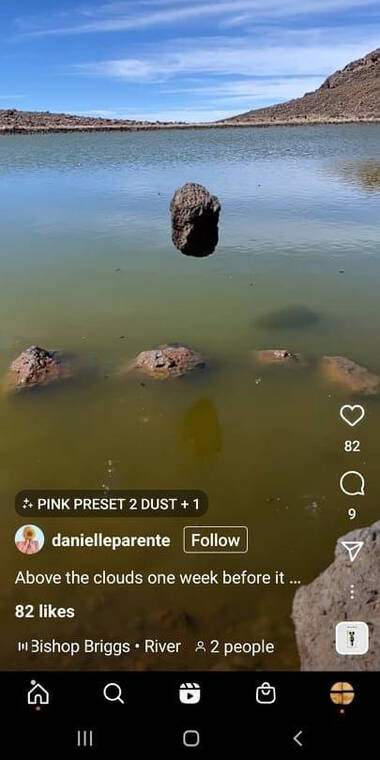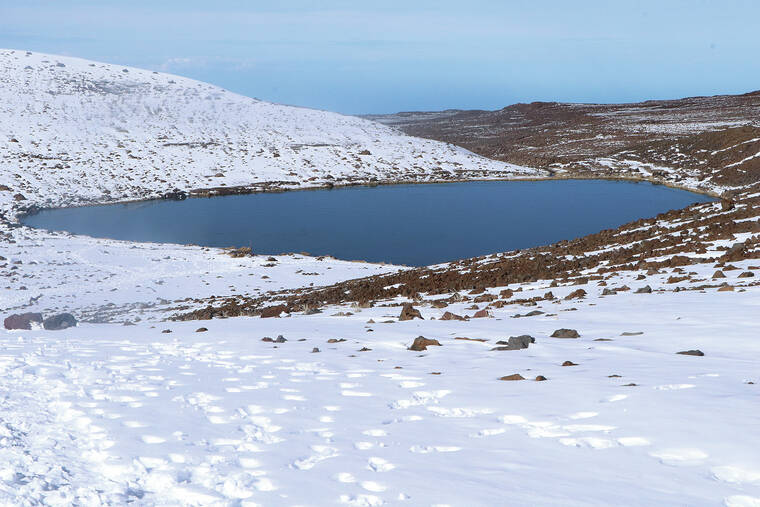A woman apologized Tuesday evening for posting photos and video earlier this month of large rocks being thrown into Lake Waiau atop Maunakea after her actions caught the attention of conservation managers and law enforcement.
The rock-throwing photos were posted on social media by a woman claiming to be a “Brooklyn based singer/songwriter” who had recently performed in Honolulu. The visuals drew the ire of many locals in mid-December as the incident blew up on social media before she apparently removed the post.
On Tuesday, after the state Department of Land and Natural Resources issued a press release on the incident, the woman apologized using her Instagram account to tell the public that she didn’t realize that the action atop the sacred mountain was disrespectful. Several hours later she made her account private, leaving the post unable to seen by non-followers.
“I sincerely apologize for the video I posted and removed immediately when it was brought to my attention. I filmed someone else throwing a rock in the lake. I didn’t realize that was disrespectful and would never disrespect the land, the people or the culture. I was aware that you don’t take rocks or sand from Hawaii. I was not aware it was disrespectful to throw a rock in the lake. Thanks to everyone that informed and again it was never my attention to be disrespectful,” she wrote. “I’m getting a lot of hateful messages. It was an honest mistake and I will make sure to do more research next time.”
Lake Waiau, situated in Puuwaiau cinder cone more than 13,000 feet above sea-level on Maunakea, is culturally significant. According Hawaiian mythology, three deities (goddesses) inhabited the area: Lilinoe, the goddess of the mist; Poliahu, the goddess of the snow; and Waiau who is said to live near and bathe in Lake Waiau.
“(The woman) came up here and decided it was a good idea to throw rocks into the lake. There are several obvious reasons this is upsetting, both to the ecological community that lives here and to the Native Hawaiian community. It can be seen as pretty disrespectful tossing large rocks into a place that Hawaiian culture reveres and holds in such high regard,” said Jordan “Kama” Lee-Loy, a specialist with the DLNR Division of Forestry and Wildlife Natural Area Reserve System.
The DLNR said Tuesday it has reached out to the woman without response. Lee-Loy said that while the woman may not have meant to be disrespectful, she needs to understand the level of disrespect the action had for the people who visit Lake Waiau culturally, ancestrally, and those who have ties to the place.
“Though she may not have meant any ill will, whenever you visit anyplace and are unfamiliar with the cultural practices, the best idea is to understand the connection to the people and how you can respectfully visit a place without causing a disturbance or disrespectful action,” he added.
Signs near the trailhead to the lake clearly identify Waiau as a Hawaiian sacred site, and that swimming, use of watercraft, and rock piling are prohibited.
“The Natural Area Reserve System was established to protect representative examples of natural history, land, and water areas which support unique Hawaiian ecosystems,” one of the signs reads. It furthers asks for all visitors to help maintain the reserves in their natural state.
Offerings left at the side of Lake Waiau also got Lee-Loy’s attention.
“We don’t want to limit traditional and customary practices, but I’m pretty sure an orange left as an offering is not culturally significant. We ask for everyone to be mindful not to inadvertently introduce invasive species like ants or non-native plants by leaving them as offerings,” he said.
Lake Waiau is one of the highest elevation lakes in the U.S. Its size fluctuates considerably as water levels change, largely dependent on precipitation amounts from snow and rain. This weekend, the alpine lake appeared nearly full with a mantle of snow surrounding the water.
That area of the mauna is in the Natural Area Reserve, a part of the DLNR. Filming without a permit on the summit is prohibited, as is using a drone, however, many profit-driven social media sites clearly show drone footage of the surrounding peak including images of snowboarders careening down the mountain in recent days.
The DLNR, which is oversees enforcement, did not respond to questions regarding enforcement and penalties as of press-time Tuesday.






